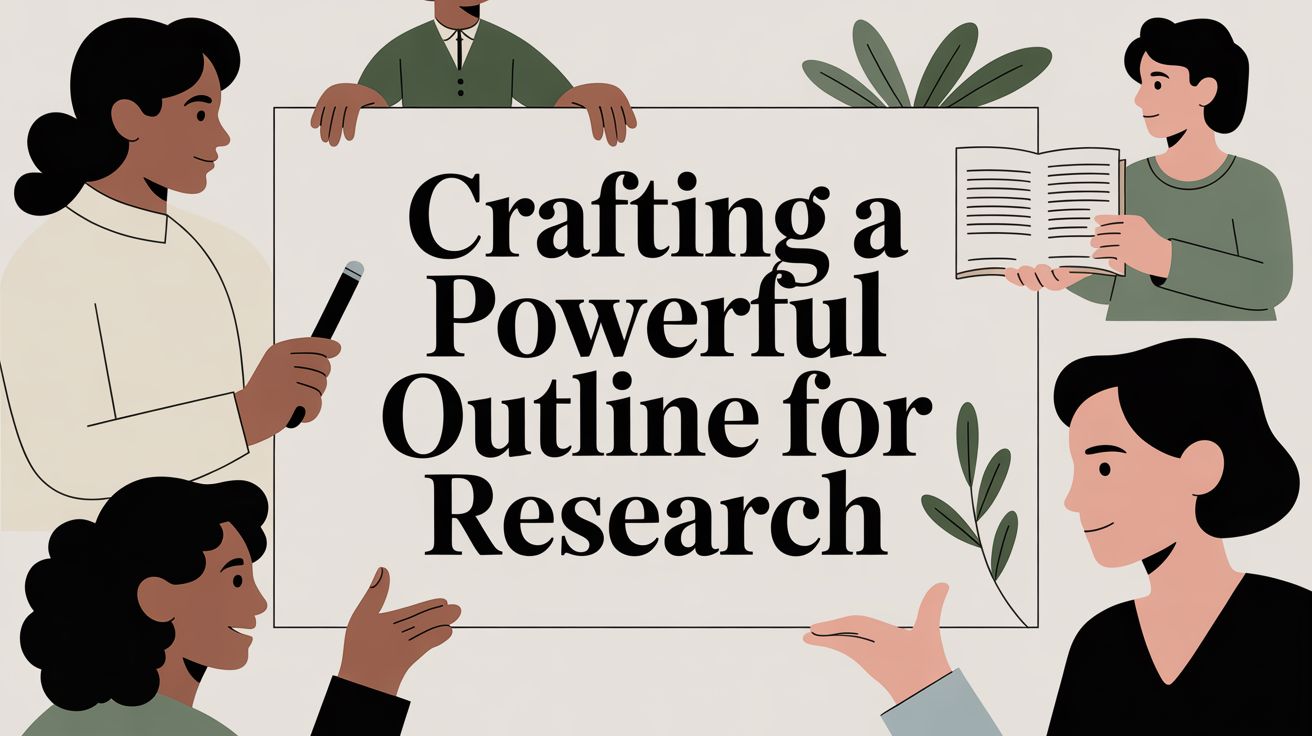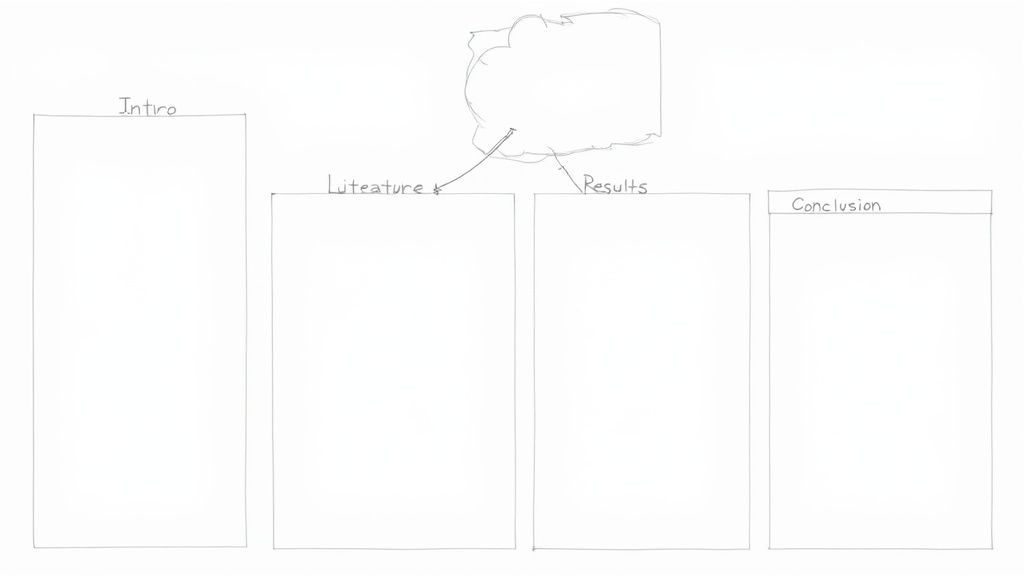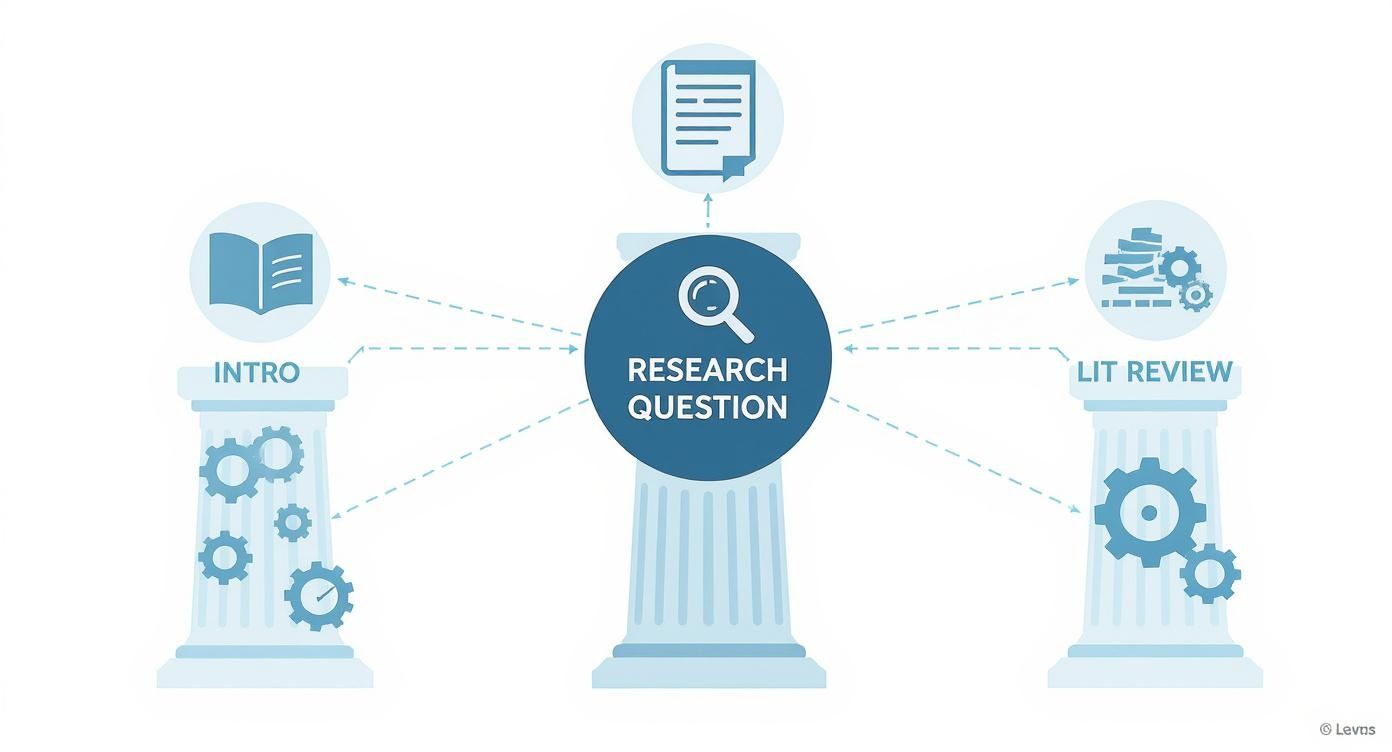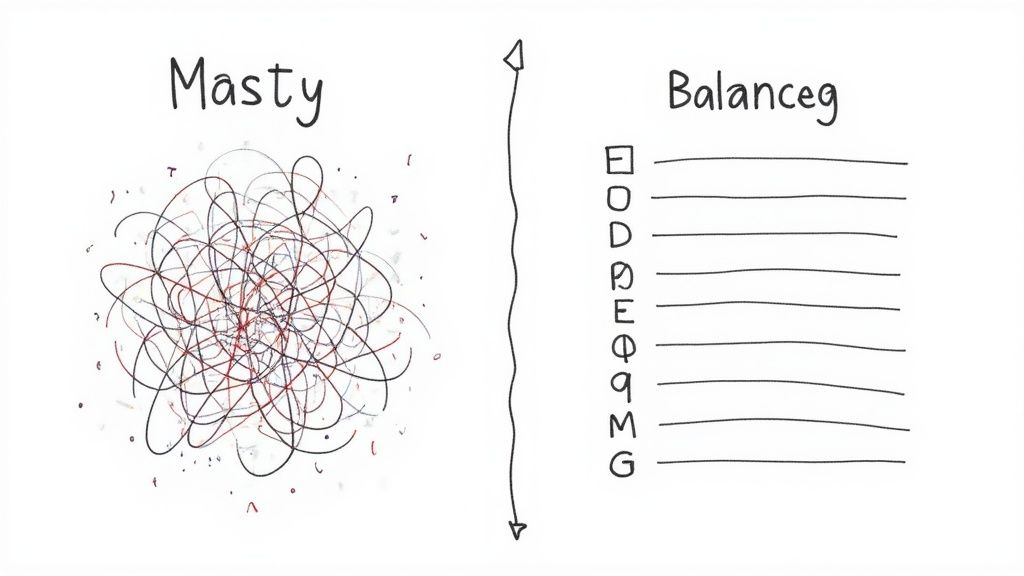Crafting a Powerful Outline for Research
Learn how to create a powerful outline for research that streamlines your writing process. Get practical tips and examples for any academic paper or thesis.

A research outline is your game plan. It’s the structured plan you create before you start writing that organizes your thoughts, arguments, and evidence. Think of it as a strategic blueprint that breaks your paper down into logical chunks—introduction, literature review, methodology, conclusion—to make sure the final piece is focused and flows smoothly.
Why Your Research Paper Needs a Strategic Outline

Before a single sentence of your paper gets written, the most important work has already begun. Crafting a solid outline isn’t just some preliminary step you can skip; it's the foundation for your entire project. It's like an architect's drawing for a building—without it, you're just guessing where the walls and windows should go.
A good research outline is your roadmap, guiding you from that initial research question all the way to your final conclusion. This structured approach helps you sidestep the common pitfalls that so often derail academic projects: disorganized arguments, writer's block, and hours wasted chasing down irrelevant tangents.
Transform Chaos into Coherence
At its heart, an outline takes a chaotic mess of notes, sources, and ideas and turns it into a logical, persuasive story. It forces you to think critically about how every piece of information actually connects to your central thesis.
This process gives you some real advantages:
- Logical Flow: It makes sure your arguments build on each other in a way that makes sense.
- Identifies Gaps: It shines a spotlight on weaknesses or missing links in your logic before you've spent hours writing.
- Saves Time: By mapping everything out first, you avoid massive rewrites and structural changes later on.
- Maintains Focus: It keeps you tethered to your main research question, so your paper doesn't wander off-topic.
When you're juggling dozens of sources, having this clear structure is a lifesaver. As you start gathering and analyzing papers, your outline lets you slot key findings into the right sections. To get a head start on this, our guide on how to read scientific papers has some great techniques for pulling out crucial information quickly.
An outline is more than a to-do list; it's a diagnostic tool. It tests the strength of your argument before you commit to it, allowing you to see the entire logical structure of your paper at a glance.
To help you get started, here's a quick look at the essential elements that form the foundation of any strong research outline.
Core Components of an Effective Research Outline
| Component | Purpose | Example |
|---|---|---|
| Thesis Statement | States the main argument or purpose of the paper. | "This study argues that gamification in primary education significantly improves student engagement in STEM subjects." |
| Major Sections | Divides the paper into logical parts (e.g., Intro, Methods). | Introduction, Literature Review, Methodology, Results, Discussion, Conclusion |
| Key Points/Subheadings | Breaks down each major section into specific topics. | Under "Methodology": 2.1 Study Design, 2.2 Participant Selection, 2.3 Data Collection |
| Supporting Evidence | Lists the sources or data points for each key point. | For 2.3 Data Collection: Cite specific surveys used (e.g., Smith et al., 2021) or mention datasets. |
| Transitions | Notes how one section or point will connect to the next. | "Concluding the literature review, the identified gap leads directly to our methodological approach..." |
Ultimately, your goal is to build a framework where your literature review, methodology, and conclusions all line up perfectly. This kind of strategic planning is what ensures your final paper isn't just a jumble of facts, but a clear, impactful, and persuasive piece of research.
Building the Foundational Pillars of Your Outline
Every solid piece of research, from a quick empirical study to a sprawling thesis, rests on a few essential pillars. Think of these as the skeleton of your outline. Get them right from the start, and the whole writing process becomes ten times easier.
The absolute ground zero for any project is a sharp, focused research question. This isn't just a general topic; it's a specific, arguable question your paper is going to answer. It's the difference between a vague idea like "social media's effects" and a laser-focused question like, "How does daily Instagram use influence the self-esteem of adolescents aged 13-18?"
Your hypothesis flows directly from that question. It’s your educated guess—a clear, testable statement you’ll try to prove or disprove. For instance, "Daily Instagram use is negatively correlated with self-esteem levels in adolescents aged 13-18." These two elements will guide every other decision you make.
Crafting a Compelling Introduction
Your introduction does more than just ease the reader in. It’s your chance to grab their attention, set the scene, and declare your mission. A well-planned intro in your outline should always include a few key things:
- The Hook: Start with something that makes people sit up and listen—a surprising statistic, a relatable story, or a bold statement that opens up the topic.
- Background Context: Give a quick rundown of what we already know. What’s the current state of play? This frames the problem for the reader.
- The Problem or Gap: Pinpoint what’s missing from the existing research. This is the "so what?" factor. Why does your study even need to exist?
- Thesis Statement/Purpose: This is where you lay it all out. State your research question and hypothesis loud and clear. It’s the mission statement for your entire paper.
Mapping these points out ensures your introduction does its job: taking the reader from a broad subject area right to the heart of your specific investigation.
Structuring the Literature Review as a Narrative
So many people make the mistake of treating the literature review like a laundry list of sources. "Smith (2020) found this, then Jones (2021) found that..." Don't do that. Instead, frame it as a story that builds a compelling argument for your own work.
Organize your outline for this section by themes. Instead of going author by author, group your sources by common ideas, ongoing debates, or different methodologies. Your outline might have subheadings like "Theories of Adolescent Social Comparison" or "Methodological Approaches to Measuring Self-Esteem."
This forces you to synthesize what you've read, not just regurgitate it. As you tell this story, you'll naturally show the reader where the gap in the conversation is—the very gap your research is about to fill. Getting good at pulling out key points is essential here; if you need a refresher, our article on summarizing in reading has some great techniques.
Mapping a Clear and Replicable Methodology
The methodology section is where the rubber meets the road. It's the practical, how-to part of your paper. In your outline, this section needs to be so clear and logical that another researcher could pick it up and replicate your study exactly. It’s your recipe.
If you’re not sure which approach to take, it’s worth the time to explore different user research methods and find the best fit for what you're trying to achieve.
Your outline should break it down into a few specific components:
- Research Design: What's your overall game plan? (e.g., qualitative, quantitative, mixed-methods; experimental, correlational).
- Participants/Sample: Who or what did you study? How did you choose them?
- Data Collection Procedures: Lay out the step-by-step process for how you gathered your information (e.g., surveys, interviews, experiments).
- Data Analysis Plan: How are you going to make sense of all the data you just collected?
Your methodology outline isn't just a to-do list. It's a testament to your study's credibility. A well-thought-out plan here proves you’ve considered every logistical and analytical detail, which is what makes your results trustworthy.
Finally, make sure your outline accounts for the Results and Discussion sections. For the Results, just plan to present your findings objectively—tables and figures are your friends here. The Discussion is where you get to interpret those findings, tying everything back to your original research question and what others have said before you. By planning for this finale, you guarantee your paper ends with a satisfying answer to the very question it set out to explore.
How to Adapt Your Outline for Different Projects
https://www.youtube.com/embed/PsV0zFW5dd8
Not all research projects are cut from the same cloth. Because of this, a one-size-fits-all outline is often a recipe for frustration. The structure that works beautifully for a scientific experiment will almost certainly fall flat for a thematic literature review.
Adapting your outline for research to the specific demands of your project isn't just a good idea—it’s absolutely essential if you want to create a focused, coherent, and effective final piece.
Think of it like an architect's blueprint. You wouldn't use the same plans for a skyscraper as you would for a single-family home. Both are buildings, but their scale, purpose, and materials require entirely different plans. Your research outline functions in the exact same way, serving as the unique blueprint for the knowledge you're constructing.
This diagram really drives the point home, showing how the research question is the central hub, with every other section—introduction, literature review, methodology—branching out to support it.

This visual is a great reminder that no matter the project type, these core pillars must always connect back to and serve the primary research question. Let's dig into how you can tailor this foundational structure for four common types of research projects.
The table below gives you a quick side-by-side look at how the core components shift depending on what you're writing.
Outline Structures Compared Across Research Types
| Section | Empirical Paper | Literature Review | Thesis/Dissertation |
|---|---|---|---|
| Introduction | States problem, identifies gap, presents hypothesis | Introduces topic, defines scope, states thesis argument | Expansive introduction to the entire scope of work |
| Body Section 1 | Methods: Details study design, participants, procedures | Theme 1: Synthesizes multiple sources on a concept | Chapter 2: Lit Review: Comprehensive thematic review |
| Body Section 2 | Results: Presents objective data and findings | Theme 2: Contrasts differing views or builds on Theme 1 | Chapter 3: Methodology: In-depth design and justification |
| Body Section 3 | Discussion: Interprets results, discusses implications | Theme 3: Explores an application or identifies a gap | Chapter 4: Results: Often multiple sub-sections or chapters |
| Conclusion | Summarizes findings, notes limitations, suggests future research | Summarizes synthesis, restates thesis, highlights gaps | Chapter 5 & 6: Discussion and a final, summarizing conclusion |
As you can see, while they share DNA, the execution and emphasis of each section are quite different.
The Empirical Paper Outline
For any paper based on original data collection, the IMRaD structure is the undisputed gold standard. This acronym—standing for Introduction, Methods, Results, and Discussion—provides a clean, logical flow that tells a straightforward story of scientific inquiry.
Your outline should mirror this structure to a T, creating a clear path for your reader.
- Introduction: You'll start by stating the research problem, briefly touching on key literature to show the gap you're filling, and then clearly presenting your research question and hypothesis. This sets the stage.
- Methods: Here, you need to detail your research design, participants, materials, and procedures. Your outline for this part should read like a step-by-step checklist to ensure you cover every single aspect of how you conducted the study.
- Results: Plan this section to present your findings objectively, with no interpretation. I find it helpful to use subheadings for different analyses (e.g., "Descriptive Statistics," "Inferential Tests").
- Discussion: Now you get to interpret the results. Outline the key points that connect your findings back to your hypothesis, discuss the study's limitations, and suggest ideas for future research.
An IMRaD outline isn't just about organizing sections; it's about organizing your thinking. It forces you to separate the 'what you did' (Methods) and 'what you found' (Results) from the 'what it means' (Discussion), which is critical for clarity.
This rigid structure is a huge strength. It makes your research transparent and easy for your peers to understand, evaluate, and even replicate.
The Literature Review Outline
A literature review is a different beast entirely. You aren't presenting new data; your goal is to synthesize existing research to identify trends, pinpoint conflicts, and highlight gaps. A simple chronological or author-by-author outline just won't cut it.
Instead, your outline for this type of research must be thematic.
- Find Your Core Themes: After you've done your initial reading, start grouping your sources into conceptual buckets. These themes will become the main sections of your outline.
- Build a Narrative: Arrange these themes in a way that tells a story. You might move from broad, foundational theories to more specific applications, or you could frame it as a debate between competing schools of thought.
- Synthesize, Don't Just Summarize: Under each thematic heading, your outline should map out the key arguments from multiple sources. The bullet points should focus on how different studies confirm, challenge, or build upon each other—not just what each one says in isolation.
For instance, a literature review on remote work productivity might have thematic sections like "The Role of Autonomy in Performance," "Technological Enablers and Barriers," and "Challenges in Measuring Remote Output." This approach creates a far more compelling and insightful narrative than a simple list of study summaries.
The Thesis or Dissertation Outline
A thesis or dissertation is a marathon, not a sprint, and its outline reflects that. This is a highly detailed document, essentially a chapter-by-chapter blueprint for an entire book. The most effective way I've seen this done is to create a macro-outline of all the chapters first, and then build a separate, detailed micro-outline for each one.
A typical macro-outline might look something like this:
- Chapter 1: Introduction: Similar in spirit to an empirical paper's intro, but much more expansive. It has to set up the entire scope of your work.
- Chapter 2: Literature Review: This is a comprehensive, deeply thematic review of your field.
- Chapter 3: Methodology: A very deep dive into your research design, with thorough justification for every choice you made.
- Chapter 4: Results: The presentation of your findings, which is often broken into multiple sub-sections or even separate chapters if the project is particularly large.
- Chapter 5: Discussion: A thorough interpretation of your results, placing them in the context of the wider literature you reviewed in Chapter 2.
- Chapter 6: Conclusion: This chapter summarizes your contribution to the field, honestly acknowledges the limitations, and points toward new avenues for research.
Once you have this chapter structure locked in, you can treat each chapter like its own mini-paper and build a detailed outline for it. This modular approach makes the monumental task of writing a dissertation feel much more manageable.
The Professional Report Outline
When you're writing for a business or professional audience, the game changes. Your reader is almost always short on time and focused squarely on practical outcomes. Your outline for a professional research report needs to prioritize clarity, brevity, and actionable insights above all else.
The structure should be built for direct communication.
- Executive Summary: This is, without a doubt, the most crucial part. Your outline must put this first. Plan to summarize the key findings and your top recommendations right up front for the busy executive.
- Introduction/Background: Briefly outline the problem or objective that prompted the report in the first place. Get to the point quickly.
- Methodology/Approach: A concise, non-technical explanation of how you gathered the information.
- Findings: Present the key data clearly. Use subheadings based on themes or key questions. This is where you'll plan to insert charts and graphs for visual impact.
- Recommendations: This section has to be action-oriented. Each point in your outline should be a specific, actionable suggestion that flows directly from the findings.
- Conclusion: A very brief wrap-up to reinforce the main takeaway message.
- Appendices: This is your secret weapon. Plan to move all the detailed data, extra charts, or dense technical information here to keep the main body of the report clean, focused, and scannable.
Using AI Tools to Build Your Outline Faster

We've all been there: staring at a mountain of research papers, feeling the weight of the hours it'll take to manually sift through every single one. It’s a classic academic rite of passage, but it’s also a huge bottleneck. Today, we can work smarter, not just harder.
Using an AI-powered tool like a PDF summarizer can dramatically speed up the initial heavy lifting. This isn't about cutting corners; it's about shifting your time from tedious reading to high-value thinking and synthesis.
Extracting Key Points with a PDF Summarizer
First things first, gather your core collection of research papers—those foundational articles that will form the backbone of your project. Once you have five to ten essential PDFs, you can upload them directly into a tool like PDF Summarizer.
This is where the process gets really efficient. Instead of reading each 20-page paper from start to finish, you can prompt the AI to extract specific, high-value information for you.
Think of the AI as your personal research assistant. You give it targeted commands, and it pulls exactly what you need for your outline.
Here are a few prompts I’ve found incredibly useful:
- "Summarize the main argument and key findings from each of these papers."
- "What were the methodologies used across these documents? List them out."
- "Identify any recurring themes or contradictions in the discussion sections."
- "Pull all direct quotes related to [your specific topic] and cite the source page."
This approach lets you quickly harvest the most relevant information from a huge amount of text, turning hours of reading into minutes of targeted extraction.
Synthesizing AI-Generated Notes into Thematic Groups
Once the AI has pulled the raw data for you, your job—the human job—is to apply critical thinking. You'll have a collection of summarized arguments, methodological notes, and key findings. Now it's time to organize them.
Start by looking for patterns. Group related points into thematic clusters. For example, you might create categories like "Common Methodological Flaws," "Key Debates in the Field," or "Evidence Supporting Hypothesis A."
The real value here is how quickly you can get from raw text to organized insights, which is the core of building a strong literature review section for your outline.
The broader adoption of artificial intelligence in research is fundamentally changing how scholars approach their work. In fact, a huge shift is underway, with around 83% of market research professionals planning to integrate AI into their work by 2025. This trend points toward a future where AI handles the massive data processing, leaving researchers to focus on the big-picture analysis.
Translating Synthesized Points into Your Outline
With your thematic clusters of notes ready, you can now directly populate the different sections of your outline. This is where you see the time savings really pay off.
That cluster you labeled "Key Debates in the Field" can become the subheadings for your literature review. Your notes on "Common Methodological Flaws" can help you justify your own methodological choices. The extracted findings can even help you draft potential points for your discussion section.
To really appreciate how this works, it helps to have a basic grasp of the underlying tech, like understanding Natural Language Processing (NLP), which allows these tools to interpret and summarize text so effectively.
The goal isn't to let the AI write your outline for you. The goal is to use AI to handle the tedious data extraction, freeing up your cognitive energy for the more important work of analysis, synthesis, and critical thinking.
This workflow transforms outlining from a daunting task into a manageable—and even creative—process. You can build a comprehensive and well-supported outline for research in a fraction of the time, letting you get to the most important part: crafting a truly compelling argument.
Common Outlining Mistakes and How to Sidestep Them

A bad outline can torpedo your project before it even starts. It gives you a false sense of security, sending you down a path that inevitably leads to painful, time-consuming rewrites. After years of doing this, I've seen that the most effective researchers learn to spot these traps from a mile away.
The whole point is to build a flexible guide that helps you write—not a rigid cage that holds you back. Let's walk through the most common outlining blunders I see and, more importantly, how to avoid them.
The "Vague Placeholder" Problem
This is easily the most frequent mistake. It's when an outline consists of generic, unhelpful placeholders like "Introduction," "Lit Review," or "Results." That’s not a plan; it’s just a table of contents.
Relying on this kind of vagueness means you're forced to make crucial structural decisions while you're trying to write. It completely defeats the purpose of outlining. It’s like a builder’s blueprint just saying, "Put some walls here." Not very helpful.
How to Fix It:
- Swap Nouns for Verbs: Instead of "Literature Review," write something actionable like, "Analyze studies on X to expose the gap in Y."
- List Your Core Arguments: Under each heading, jot down the actual points you plan to make. For "Results," you might list "Present statistical analysis of Survey Group A" and "Compare response times between Group A and B."
A great outline doesn't just name the rooms; it tells you what you'll be doing in each one. Every bullet point should represent a single, focused idea that will eventually become a paragraph. It turns an abstract concept into a concrete roadmap.
Being Too Rigid and Inflexible
Of course, you can swing too far in the other direction. An outline that’s overly detailed and set in stone can be just as damaging. Research is a process of discovery. You’ll find new information, your ideas will sharpen, and your initial hypotheses might even change.
If you’re chained to an inflexible plan, you might be tempted to ignore a game-changing new study or a surprising result simply because it doesn't fit neatly into your pre-built boxes. Your outline should be a living document, not a signed contract.
Creating an Unbalanced Structure
I also see a lot of lopsided outlines. This happens when one section is planned out with military precision, while others are barely an afterthought. You might have three pages of detailed notes for your literature review but only a single, lonely bullet point for the discussion section.
This imbalance almost always leads to a disjointed paper. Some parts will feel well-argued and robust, while others come across as rushed and shallow. A solid outline for research forces you to give every part of your paper the attention it deserves, creating a much more cohesive final piece.
How to Fix It:
- Check for Proportionality: Take a step back. Does the amount of detail in each section reflect its relative importance in the final paper?
- Flesh Out the Weak Spots: If your "Conclusion" section is just one line, spend just 15 minutes brainstorming the key takeaways, implications, and future research directions you’ll want to hit. Getting that balance right is crucial.
Ultimately, avoiding these pitfalls means treating your outline as the strategic tool it is. It's your sandbox—a place to test your logic, arrange your thoughts, and build a sturdy framework before you start laying the bricks. If you're struggling to pull out key arguments to build a better structure, it can be helpful to learn how to summarize a research paper to get to the core ideas faster.
Frequently Asked Questions About Research Outlines
Even with the best intentions, you’re bound to hit a few snags when you sit down to create your outline. That's perfectly normal. Knowing the answers to a few common questions can mean the difference between getting stuck and keeping your momentum.
Think of this section as a quick troubleshooting guide for those little hurdles that pop up during the planning stage. We'll tackle everything from how granular you need to get to what to do when your research veers off in a completely new direction.
How Detailed Should a Research Outline Be?
This is a classic "it depends" situation, but a good rule of thumb is to aim for a balance between structure and freedom. Your outline should be more than a list of topics, but it definitely shouldn’t be a full-blown first draft. The sweet spot is often where each main point or sub-point could realistically become a single, well-developed paragraph in your final paper.
For a massive project like a dissertation, your outline will naturally be more layered:
- Chapter Titles: These are your highest-level buckets.
- Section Headings: Break down the core arguments within each chapter.
- Key Points: A few bullet points under each heading, noting the specific evidence, claims, or data you'll introduce.
But for a shorter empirical paper, you might just need section headings with a handful of bullet points to map out the flow of your argument. The real goal is to build a scaffold that lets you write without constantly second-guessing your structure, while still leaving room for new ideas to emerge.
What Is the Best Software for Creating an Outline?
Honestly, the best tool is the one you’ll actually use. There’s no magic bullet here, and what works for one person might feel clunky to another.
Plenty of researchers do just fine with the built-in heading and navigation panes in Microsoft Word or Google Docs. They're simple, they're already there, and for most standard papers, they're more than enough to get the job done.
If you’re wrestling with a really complex project, though, you might want something with a bit more horsepower:
- Scrivener or OmniOutliner: These are fantastic for long-form writing. They let you easily drag and drop entire sections, view your project from different angles, and keep all your notes and sources in one place.
- Miro or XMind: If you're a visual thinker, a mind-mapping tool can be a game-changer. It’s a great way to brainstorm connections and see the big picture before you lock yourself into a linear structure.
My advice? Try a couple of different options. A free trial is usually all it takes to figure out which one clicks with the way you think.
An outline is a living document, not a contract set in stone. It's perfectly normal—and even desirable—for your research direction to evolve as you uncover new information.
What if My Research Direction Changes?
First, don't panic. This happens all the time—in fact, it's often a sign of good research. When your findings pull you in a new direction, the worst thing you can do is ignore it. Instead, go straight back to your outline.
Think of it like updating your GPS after an unexpected detour. Start by tweaking your main research question or hypothesis to reflect your new focus. Since that's the anchor for the entire project, it has to be right. Then, work your way down, adjusting the other sections to align with this change. You might need to add new literature, re-think your methodology, or completely shuffle the points in your discussion.
Keeping your outline updated ensures it remains a genuinely useful tool that reflects where your project is, not where you thought it was going to be. This simple habit will save you from writing a final paper that feels disconnected or all over the place.
Ready to build your next research outline faster than ever? PDF Summarizer lets you upload multiple papers, ask questions across all your sources, and extract key findings in seconds. Turn hours of reading into a focused, well-structured plan. Try PDF Summarizer for free today and see how AI can accelerate your research.
Relevant articles
Discover the best AI tools for academic research. Our curated list covers literature reviews, data extraction, writing, and summarization to speed up your work.
Discover how to conduct a literature review with a practical, step-by-step guide covering scope, synthesis, and reporting findings.
Discover the top 12 tools to streamline your writing. Find the perfect alphabetizer for citations to create flawless reference lists effortlessly.
Discover how a research paper summarizer uses AI to distill key insights from dense texts. Learn how these tools work and how to use them effectively.
Learn how to summarize a research paper with clear guidance on reading tactics, note taking, concise abstracts, tools, and common pitfalls.




